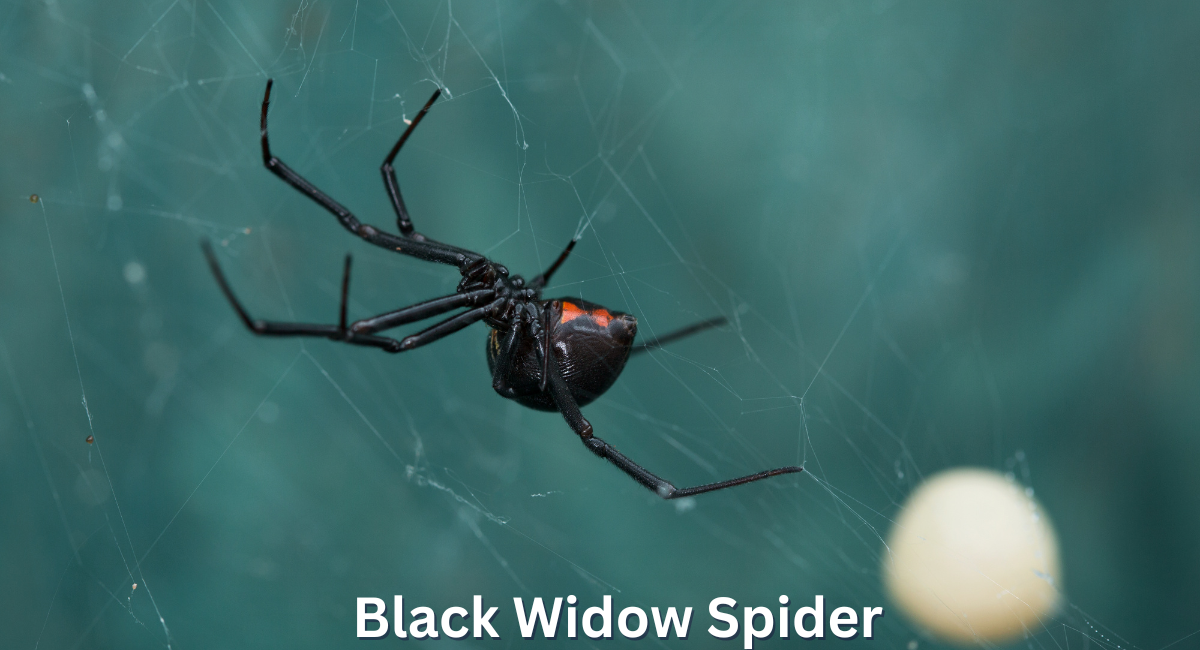The Black Widow Spider is widely recognized for its distinctive appearance and potent venom. Its glossy black body and striking red hourglass marking on the abdomen make female spiders easy to identify. While their bites can be dangerous, particularly to young children and people older than 70, fatalities are rare due to effective medical treatments. The neurotoxic venom of the Black Widow affects the nervous system, leading to symptoms such as muscle pain, cramping, and, in severe cases, more serious health complications. This reputation as a deadly spider contributes to the fear and misunderstanding surrounding this fascinating arachnid.
The Black Widow Spider, though categorized among venomous spiders, is not inherently aggressive. It usually bites only in self-defense. These spiders prefer avoiding human encounters and often hide in dark, undisturbed areas such as woodpiles, garages, and sheds. Understanding their behavior and natural habitat can help reduce the likelihood of unwanted interactions. Additionally, public education about the Black Widow can dispel myths surrounding its danger and promote a balanced perspective, highlighting the importance of these spiders in controlling insect populations and maintaining ecological harmony.
Characteristics of the Black Widow Spider
The Black Widow Spider is renowned for its distinctive physical characteristics, which contribute to its reputation as one of the deadliest spiders in the world. Females are particularly recognizable due to their glossy black bodies and the iconic red hourglass marking on their abdomens. This striking coloration serves as a warning to potential predators, indicating their toxicity. Male Black Widow Spiders are generally smaller and less conspicuous, often lacking the prominent red marking. Measuring about 1.5 inches in length, females are significantly larger than males. These spiders prefer dark, secluded environments such as woodpiles, basements, and sheds, where they build irregular webs that are less dense than those of other spider species.
In addition to their notable appearance, the Black Widow Spider possesses a potent venom that classifies it among the . The venom contains neurotoxins that can affect the nervous system of their prey, which mainly consists of insects. Although their bites can be extremely painful and result in serious symptoms, fatalities are rare due to advancements in medical treatment. The bite typically causes muscle spasms, pain, and other systemic reactions, especially in children and the people older than 70. Understanding these characteristics not only aids in the identification of the Black Widow Spider but also emphasizes the importance of respecting their role in the ecosystem as natural pest controllers.
Habitat and Distribution
The Black Widow Spider is primarily found in temperate regions across the globe. It is especially common in the United States, where it inhabits a variety of environments. These spiders thrive in dark, undisturbed areas such as wood piles, sheds, basements, and under rocks. These locations allow them to build their characteristic tangled webs. The Black Widow Spider can also be found in gardens and shrubs. They often seek shelter in areas that provide cover and protection from predators.
Although their distribution is widespread, the Black Widow Spider prefers warmer climates. This preference leads to a higher population density in southern regions during the warmer months. Understanding the habitat preferences of these spiders is essential for both human safety and conservation efforts.
In addition to the Black Widow Spider, many other venomous creatures share similar habitats. Some of these include some of the deadliest snakes in the world. This highlights the ecological complexity of these environments. Just as the Black Widow plays a role in controlling insect populations, the presence of these snakes helps maintain a balanced ecosystem.
Although both the Black Widow Spider and the deadliest snakes are often viewed with fear, they are crucial for the health of their habitats. Awareness of their habitats and distributions can lead to better management practices. It also fosters a greater appreciation for the biodiversity present in our ecosystems.
Behavior and Diet
The Black Widow Spider exhibits unique behavior that contributes to its survival in various environments. These spiders are primarily nocturnal. They prefer to remain hidden during the day in dark, secluded areas like woodpiles, basements, and sheds. The Black Widow creates irregular, tangled webs. These webs serve as both a habitat and a trap for their prey. When an unsuspecting insect becomes ensnared, the Black Widow uses its agility and stealth. It approaches and injects venom to immobilize the prey before consuming it. This hunting technique is effective in capturing a wide range of insects. It demonstrates the adaptability of the Black Widow in diverse ecosystems.
In contrast, the Sydney Funnel Spider has a more aggressive feeding strategy. While both spiders play significant roles in their respective ecosystems, the Sydney Funnel Spider is known for its potent venom and burrowing behavior. It often constructs deep silk-lined burrows. The spider waits for prey to come close before ambushing them. This method of hunting is particularly effective for larger insects and small vertebrates. It showcases the differences in dietary habits between these two spider species.
Understanding the behavior and diet of the Black Widow and the Sydney Funnel Spider helps to appreciate their ecological significance. It also highlights the important roles they play in controlling pest populations.
Reproduction and Lifespan
The Black Widow Spider exhibits fascinating reproductive behaviors that contribute to its unique lifecycle. Mating occurs in the spring and summer months when the female emits pheromones to attract males. Male Black Widow Spiders often perform courtship rituals to avoid being mistaken for prey by females. After mating, the female may consume the male. This behavior, known as sexual cannibalism, provides nutritional benefits and enhances reproductive success. This intriguing strategy, while grim, underscores the survival instinct inherent in the species and highlights the complex dynamics of their reproductive habits.
In terms of lifespan, the Black Widow Spider typically lives for about one to three years in the wild, although females can live longer than males due to their more sedentary nature and the energy expended by males during mating. After mating, females lay between 250 to 750 eggs in a silken egg sac, which they guard diligently until they hatch. The young spiders emerge as tiny replicas of their parents and are initially vulnerable, often relying on their mother’s protection. As they mature, they develop their distinctive coloration and markings. Understanding the reproduction and lifespan of the Black Widow Spider offers valuable insights into their ecological role and the survival strategies they employ throughout their life cycle.
Myths and Misconceptions
The Black Widow Spider is often shrouded in myths and misconceptions that contribute to its fearsome reputation. One prevalent myth is that all black spiders are Black Widows, which is not true. While they do have distinctive features—such as their glossy black bodies and the signature red hourglass marking—many other spider species can be black and harmless. Additionally, people often believe that the bite of a Black Widow is always fatal, but this is misleading. Although their venom is potent, fatalities are extremely rare because medical treatments have advanced, and people usually get bitten only when they accidentally provoke the spider.
Another common misconception is that the Black Widow Spider aggressively seeks out humans to bite them. In reality, these spiders are reclusive and prefer to avoid encounters. They typically bite only when they feel threatened or cornered, which often happens when someone inadvertently disturbs their habitat. Understanding these myths can help alleviate unnecessary fear and promote a more informed perspective on the role of the Black Widow in our ecosystems. They play a crucial part in controlling pest populations, thus contributing to the balance of their environments.
Conservation Status
The Black Widow Spider plays a key role in the ecosystem, making its conservation status vital for ecological balance. It is not currently endangered, but habitat destruction and climate change pose risks. Urban development, agricultural practices, and pollution disrupt their natural habitats, leading to population declines. Conservation efforts must focus on preserving environments and educating the public about their importance.
Raising awareness of their role in pest control can help people appreciate these misunderstood arachnids. This can also support conservation efforts. Protecting their habitats ensures that Black Widow populations remain stable.
Research on the Black Widow Spider is crucial for understanding its biology, behavior, and contributions to science. Its venom has potential applications in pain management and neurological studies. By preserving their habitats, scientists can continue researching these fascinating creatures.
Promoting conservation strategies and emphasizing biodiversity is essential. This helps the Black Widow Spider thrive while contributing to ecosystem health and scientific advancements.
Conclusion
The Black Widow Spider, with its striking appearance and unique behaviors, plays an essential role in the ecosystem as a predator of insects. Understanding its characteristics, habitat, and contributions to pest control can help foster a more positive perception of these misunderstood creatures. While their venomous bite requires caution, it is equally important to recognize the ecological benefits they provide. By promoting awareness and conservation efforts, we can appreciate the Black Widow Spider’s role in maintaining a healthy balance in nature.



